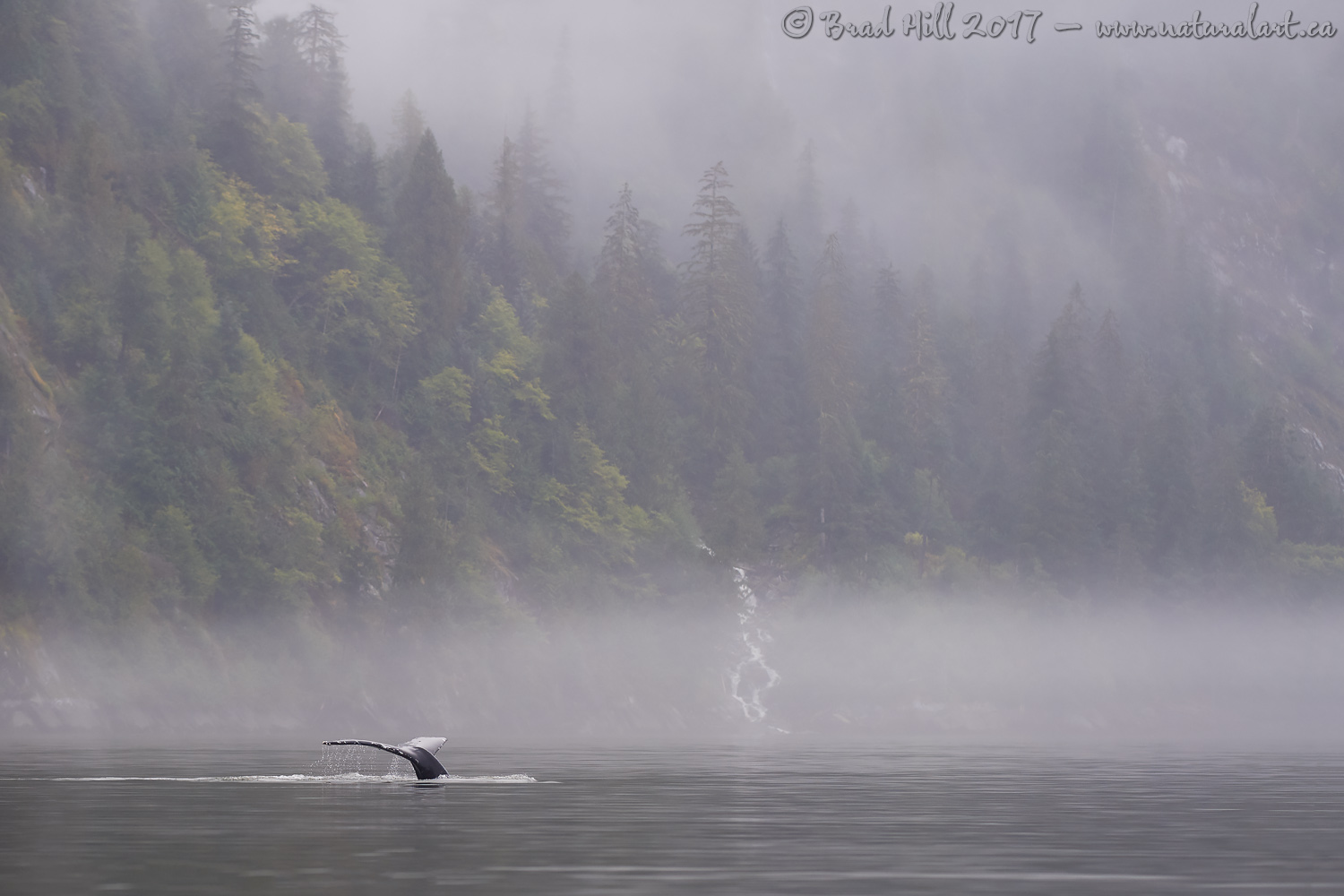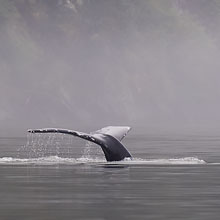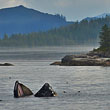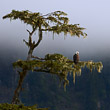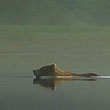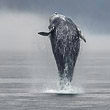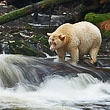Availability: Limited Edition Print - info coming soon!
In the Field
A September Great Bear Morning. Great Bear Rainforest, Northern BC Coast, Canada. September 25, 2017.
One of my favourite animalscapes* from 2017...
This scene typifies what I love about the Great Bear Rainforest - it offers up some of the most moody and "atmospheric" scenes imaginable. And, best of all, those scenes often contain spectacular wildlife (like this diving Humpback Whale)! If you're into "almost painterly" naturally-produced scenes I can think of no better place for a nature photographer to visit!
I captured this image in late September of 2017 using a Nikon D5 (not a D850!) and Sigma's excellent 120-300mm f2.8 Sport lens. In 2013 and early 2017 I borrowed a copy of this lens from Canada's Sigma distributor (Gentec International) and both times I found I was very reluctant to return it! So...shortly before my annual foray into the Great Bear Rainforest I purchased my own copy of the lens. By the end of my trip I was incredibly happy that I did - some of my most memorable shots from the trip were captured with the Sigma 120-300.
Why has this lens "hit the sweet spot" for me? While no one will ever call this a lightweight lens, it is an absolute heavyweight when it comes to optical performance. I've found the lens to be amazingly sharp edge-to-edge at all focal lengths and all apertures, including on the new (at the time of this writing) and demanding 45.7 MP Nikon D850. How sharp? Well...many are considering the new Nikkor 70-200mm f2.8E VR to be the new "reference standard" for extreme sharpness in a telephoto zoom lens - and the Sigma 120-300mm f2.8 Sport matches that lens step for step in sharpness at all overlapping focal lengths! I also find the focal length range of the lens just superb for many animalscape shots (like this one!) and, of course, the wide maximum aperture gives me the ability to isolate subjects from their background with ease. And, if I'm shooting my D500, the lens gives me the equivalent of a 180-450mm f4 zoom (in terms of DoF) while still retaining the light-gathering characteristics of an f2.8 lens. Pretty sweet!
Here's a larger (2400 pixel) version of this almost painterly scene:
• A September Great Bear Morning: Download 2400 pixel image (JPEG: 1.0 MB)
ADDITIONAL NOTES:
1. This image was captured during my autumn"Into the Great Bear Rainforest" Instructional photo tour in the summer of 2017. Each year I offer trips into two different parts of the Great Bear Rainforest as well as one to photograph marine mammals and oceanscapes near the northern tip of Vancouver Island. And, in selected years, I also offer photo tours to locations to capture other highly sought-after subjects, such as Dall Sheep, Bald Eagles, and more. Details about these trips can be found on the Photo Tours page of this website.
2. This image - in all resolutions - is protected by copyright. I'm fine with personal uses of them (including use as desktop backgrounds or screensavers on your own computer), but unauthorized commercial use of the image is prohibited by law. Thanks in advance for respecting my copyright!
3. Like all wildlife photographs on this website, this image was captured following the strict ethical guidelines described in The Wildlife FIRST! Principles of Photographer Conduct. I encourage all wildlife photographers to always put the welfare of their subjects above the value of their photographs.
*4. For a more detailed discussion of the image types I call animalscapes and enviroscapes (and the subtle distinctions between them), just go here...
Behind the Camera
A September Great Bear Morning. Great Bear Rainforest, Northern BC Coast, Canada. September 25, 2017.
Digital Capture; Compressed RAW (NEF) 14-bit format; ISO 560.
Nikon D5 paired with Sigma 120-300mm f2.8 Sport lens at 155mm. Hand-held from floating Zodiac. OS on and in "OS1" mode, with image stabilization customized to Moderate View mode; AF customized to Fast Priority AF.
1/1250s @ f4; No compensation from "recommended" matrix-metered exposure setting.
At the Computer
A September Great Bear Morning. Great Bear Rainforest, Northern BC Coast, Canada. September 25, 2017.
RAW Conversion to 16-bit TIFF using Phase One's Capture One Pro 10. Two raw variants (different versions of a single raw capture) processed, with the variants differing only slightly in exposure settings (0.2 stops total). Other adjustments during raw conversion (for both variants) included tweaks to Levels and a desaturation of the background green colors.
Further digital correction on resulting 16-bit TIFF files using Adobe's Photoshop CC 2017. Photoshop adjustments included compositing (blending) of the two output files from the raw converter, selective curves (contrast) adjustment to "tease apart" some of the subtle tones in the background, and final selective sharpening for web output.
Conservation
A September Great Bear Morning. Great Bear Rainforest, Northern BC Coast, Canada. September 25, 2017.
Ten percent of the revenue generated by this image will be donated to Raincoast*.
Species Status in Canada**: Threatened - North Pacific population (May 2003).
Humpback Whales (Megaptera novaeagnliae) are active, acrobatic whales that can throw themselves completely clear of the water (a behaviour known as breaching) and will swim on their backs with both flippers in the air. Humpbacks are large (up to 14m - or 46 feet - in length and 40 tonnes in weight) and with huge flippers.
Humpbacks are found in tropical, temperate, and sub-polar waters around the world. They are found on both the east and west coasts of North America. The North Pacific population has been estimated at between 6,000 and 8,000 individuals, but only a few hundred of these are found in the waters off the coast of British Columbia.
While Humpbacks are recovering from the damage done to their populations by commercial fishing, the are still subject to a variety of threats from human activities, including becoming entangled in fishing nets, noise and chemical pollution and habitat destruction.
*The Raincoast Conservation Society (and Foundation) is an effective and efficient organization that has been fighting for protection of this unique habitat. If you are looking for a meaningful way to contribute to the conservation of this amazing ecosystem, Raincoast will provide maximal "bang" for your conservation dollars.
**as determined by COSEWIC: The Committee on the Status of Endangered Wildlife in Canada













